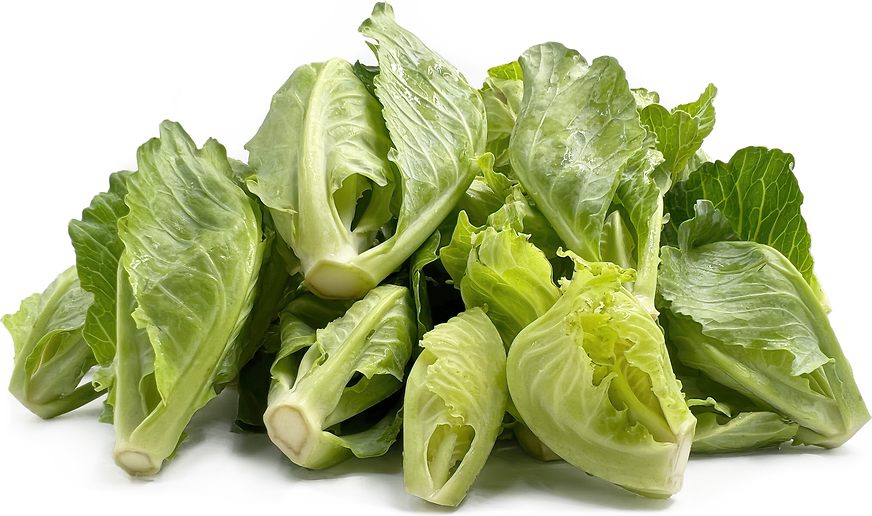


Baby Green Cabbage
Estimated Inventory, lb : 0
Description/Taste
Baby Green cabbages are small, compact heads, averaging ten centimeters in diameter, and have a round to ovate shape. The heads consist of many layers of tightly packed leaves, which are smooth, crisp, firm, and pale green. The leaves also have a slightly waxy consistency and prominent central midribs that expand into smaller veins across the surface. Baby Green cabbages, when raw, are crunchy, grassy, and sweet, and when heated, the leaves soften and develop an even milder taste.
Seasons/Availability
Baby Green cabbages are available in the fall through mid-spring.
Current Facts
Baby Green cabbages, botanically classified as Brassica oleraceae var. capitata, are small heads cultivated for their novel size and belong to the Brassicaceae family. There are many different varieties of green cabbage that can be harvested young for the Baby Green cabbage market, with the most popular cultivars, including puma and green pandion. Baby Green cabbages are grown using specific cultivation methods to create smaller heads, and the cabbages are generally ready for harvest 55-65 days after sowing. In commercial markets, the compact heads are highly favored as a specialty item for their small size, tender and crisp consistency, and mild, sweet flavor, utilized in both raw and cooked culinary applications.
Nutritional Value
Baby Green cabbage is an excellent source of vitamin K, which can help regulate nutrients in the blood and vitamin C, which is an antioxidant that can boost the immune system. The cabbages are also a good source of vitamin A and fiber, which can regulate digestion, and contain beneficial amounts of potassium, magnesium, calcium, iron, and phosphorus.
Applications
Baby Green cabbages are best suited for both raw and cooked applications such as boiling, baking, braising, steaming, and grilling. The greens can be shredded and tossed fresh into salads, or they can be mixed into coleslaws for a crunchy addition. While the cabbages can be utilized fresh, they are more popularly cooked whole or sliced in half to showcase their unique, small size. Baby Green cabbages can be stuffed with cheeses, grains, and meats, sliced and layered into gratins, lightly stir-fried with other vegetables, or stirred into pasta. They can also be tossed into soups, stews, and curries or stirred into casseroles. Baby Green cabbages pair well with cheeses such as pecorino, parmesan, and gruyere, meats such as sausage, turkey poultry, fish, and beef, seafood, celery, carrots, potatoes, tomatoes, mushrooms, fennel, and nuts such as walnuts, peanuts, and pistachios. The cabbages will keep 1-2 weeks when loosely wrapped in plastic and stored in the crisper drawer of the refrigerator.
Ethnic/Cultural Info
Cabbage is believed to be one of the oldest recorded vegetables in history and has been cultivated in Europe for thousands of years. The crisp, firm heads are especially popular in France, where they are used as a base for many soups, salads, braises, and side dishes. Cabbage became such a common element in French cooking that it also began to intertwine with the culture of daily life. In France, there are several sayings that use cabbage as a symbol, and many of these phrases are still used in the modern-day. One of the most famous sayings is “mon petit chou,” which translates to “my little cabbage.” This phrase is a term of endearment, especially towards loved ones and children, and it has been reported that even Prince Philip uses the saying as a nickname for Queen Elizabeth. Cabbages are also used in the phrase “dans les choux,” which translates to “in the cabbages,” a saying used for when someone is in trouble.
Geography/History
Green cabbage is believed to be native to southeastern Europe and central Asia and was first domesticated during the time of ancient Rome and Egypt. While the exact date of when Baby Green cabbages were first marketed as a specialty product is unknown, baby vegetables were widely found in European markets in the 20th century. Today Baby Green cabbages are grown throughout Europe, including France and Spain, and are also cultivated in the United States, South Africa, and Asia. The Baby Green cabbages featured in the photograph above were grown by Yukon Farms, which is a company based in South Africa that sources baby vegetables from farms throughout Africa and exports them to markets in Europe.
Recipe Ideas
Recipes that include Baby Green Cabbage. One
| Dinner at the Zoo |
|
Korean BBQ Tacos |
| The Kitchn |
|
Roasted Baby Cabbage |




